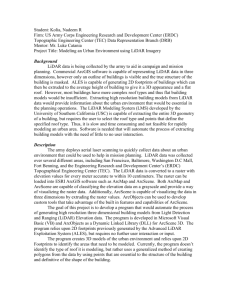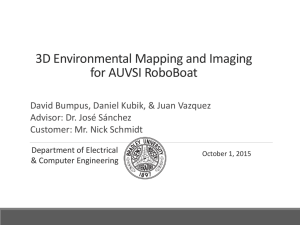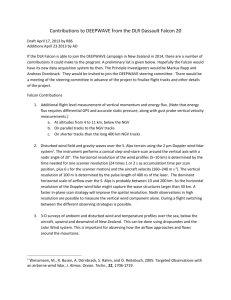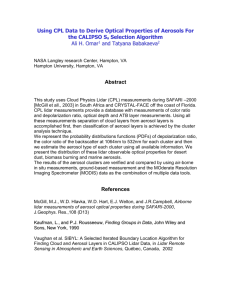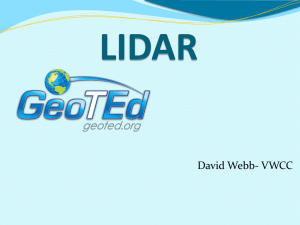Light Detection & Ranging SEMINAR REPORT
advertisement
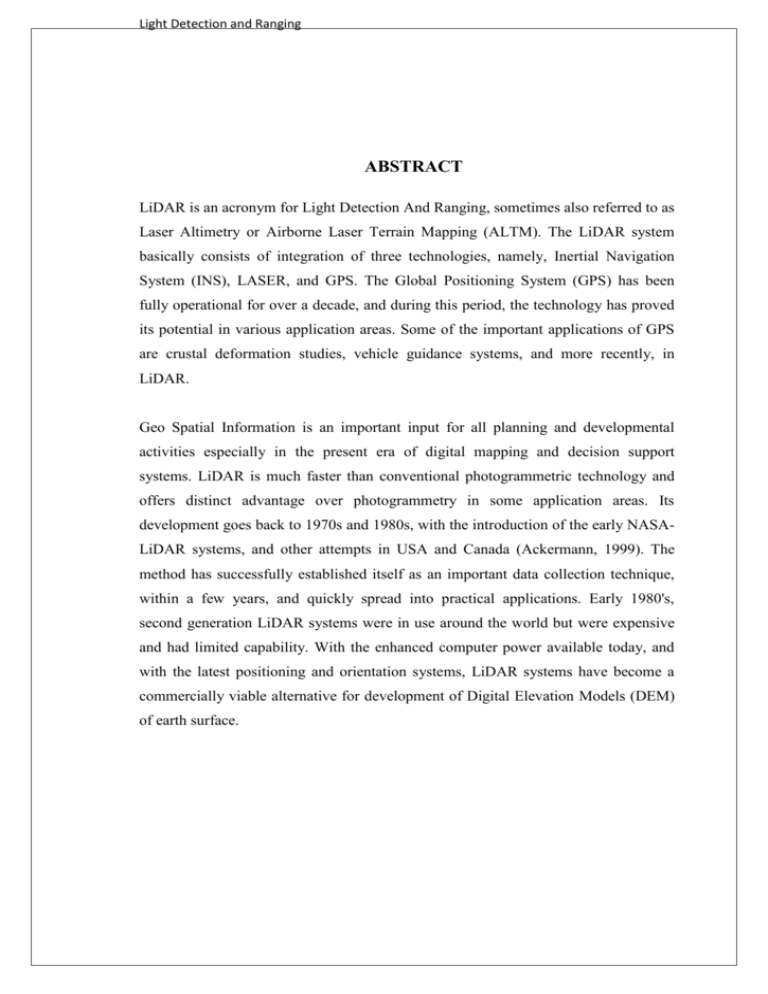
Light Detection and Ranging ABSTRACT LiDAR is an acronym for Light Detection And Ranging, sometimes also referred to as Laser Altimetry or Airborne Laser Terrain Mapping (ALTM). The LiDAR system basically consists of integration of three technologies, namely, Inertial Navigation System (INS), LASER, and GPS. The Global Positioning System (GPS) has been fully operational for over a decade, and during this period, the technology has proved its potential in various application areas. Some of the important applications of GPS are crustal deformation studies, vehicle guidance systems, and more recently, in LiDAR. Geo Spatial Information is an important input for all planning and developmental activities especially in the present era of digital mapping and decision support systems. LiDAR is much faster than conventional photogrammetric technology and offers distinct advantage over photogrammetry in some application areas. Its development goes back to 1970s and 1980s, with the introduction of the early NASALiDAR systems, and other attempts in USA and Canada (Ackermann, 1999). The method has successfully established itself as an important data collection technique, within a few years, and quickly spread into practical applications. Early 1980's, second generation LiDAR systems were in use around the world but were expensive and had limited capability. With the enhanced computer power available today, and with the latest positioning and orientation systems, LiDAR systems have become a commercially viable alternative for development of Digital Elevation Models (DEM) of earth surface. Light Detection and Ranging CONTENTS 1. Introduction 2. What is LIDAR? 3. Operation 4. Design 5. Applications 6. Advantages 7. Disadvantages 8. Conclusion 9. References Light Detection and Ranging INTRODUCTION Light Detection And Ranging is an optical remote sensing technology that measures properties of scattered light to find range and/or other information of a distant target. The prevalent method to determine distance to an object or surface is to use laser pulses. Like the similar radar technology, which uses radio waves, the range to an object is determined by measuring the time delay between transmission of a pulse and detection of the reflected signal. LIDAR technology has application in Geomatics, archaeology, geography, geology, geomorphology, seismology, forestry, remote sensing and atmospheric physics. Applications of LIDAR include ALSM (Airborne Laser Swath Mapping), laser altimetry or LIDAR Contour Mapping. The acronym LADAR (Laser Detection and Ranging) is often used in military contexts. The term "laser radar" is also in use even though LIDAR does not employ microwaves or radio waves, which is definitional to radar. The primary difference between LIDAR and radar is that LIDAR uses much shorter wavelengths of the electromagnetic spectrum, typically in the ultraviolet, visible, or near infrared range. In general it is possible to image a feature or object only about the same size as the wavelength, or larger. Thus lidar is highly sensitive to aerosols and cloud particles and has many applications in atmospheric research and meteorology. An object needs to produce a dielectric discontinuity to reflect the transmitted wave. At radar (microwave or radio) frequencies, a metallic object produces a significant reflection. However non-metallic objects, such as rain and rocks produce weaker reflections and some materials may produce no detectable reflection at all, meaning some objects or features are effectively invisible at radar frequencies. This is especially true for very small objects (such as single molecules and aerosols). Lasers provide one solution to these problems. The beam densities and coherency are excellent. Moreover the wavelengths are much smaller than can be achieved with radio systems, and range from about 10 micrometers to the UV (ca. 250 nm). At such wavelengths, the waves are "reflected" very well from small objects. This type of reflection is called backscattering. Different types of scattering are used for different lidar applications, most common are Rayleigh scattering , Mie scattering and Raman Light Detection and Ranging scattering as well as fluorescence. Based on different kinds of backscattering, the LIDAR can be accordingly called Rayleigh LiDAR, Mie LiDAR, Raman LiDAR and Na/Fe/K Fluorescence LIDAR and so on. The wavelengths are ideal for making measurements of smoke and other airborne particles (aerosols), clouds, and air molecules. A laser typically has a very narrow beam which allows the mapping of physical features with very high resolution compared with radar. In addition, many chemical compounds interact more strongly at visible wavelengths than at microwaves, resulting in a stronger image of these materials. Suitable combinations of lasers can allow for remote mapping of atmospheric contents by looking for wavelengthdependent changes in the intensity of the returned signal. LIDAR has been used extensively for atmospheric research and meteorology. With the deployment of the GPS in the 1980s precision positioning of aircraft became possible. GPS based surveying technology has made airborne surveying and mapping applications possible and practical. Many have been developed, using downwardlooking LIDAR instruments mounted in aircraft or satellites. A recent example is the NASA Experimental Advanced Research Lidar. Light Detection and Ranging What's a Lidar? A lidar is similar to the more familiar radar, and can be thought of as a laser radar. In a radar, radio waves are transmitted into the atmosphere, which scatters some of the power back to the radar's receiver. A lidar also transmits and receives electromagnetic radiation, but at a higher frequency. Lidars operate in the ultraviolet, visible and infrared region of the electromagnetic spectrum. . Choosing different types of scattering processes allows atmospheric composition, temperature and wind to be measured. LIDAR is an acronym which stands for LIghtDetection AndRanging (radar is also an acronym). A simplified block diagram of a lidar contains a transmitter, receiver and detector system. Different types of physical processes in the atmosphere are related to different types of light scattering The lidar's transmitter is a laser, while its receiver is an optical telescope. Light Detection and Ranging A FASOR used at the Starfire Optical Range for LIDAR and laser guide star experiments is tuned to the sodium D2a line and used to excite sodium atoms in the upper atmosphere. This lidar (laser range finder) may be used to scan buildings, rock formations, etc., to produce a 3D model. The lidar can aim its laser beam in a wide range: its head rotates horizontally, a mirror flips vertically. The laser beam is used to measure the distance to the first object on its path. Light Detection and Ranging OPERATION Different kinds of lasers are used depending on the power and wavelength required. The lasers may be both cw (continuous wave, on continuous like a light bulb) or pulsed (like a strobe light). Gain mediums for the lasers include, gases (e.g. HeNe = Helium Neon or Xenon Fluoride), solid state diodes, dyes and crystals (e.g. Nd:YAG = Neodymium:Yttrium Aluminum Garnet). For some lidar applications more than 1 kind of laser is used. Here is the transmitter for Western's Purple Crow Lidar, which uses both cw and pulsed lasers. The final output of both channels of the transmitter is pulsed with a pulse repetition rate of 20 times per second and a pulse width of about 7 ns (1 ns = 1 x 10-9s) . The receiving system records the scattered light received by the receiver at fixed time intervals. Lidars typically use extremely sensitive detectors called photomultiplier tubes to detect the backscattered light. Photomultiplier tubes (shown below) convert the individual quanta of light, photons, first into electric currents and then into digital photocounts which can be stored and processed on a computer. Light Detection and Ranging Amazing when you consider the electric currents generated are on the order of picoamps (1 pA = 10-12 A; a 60 W light bulb draws a current of 0.5 A!). The photocounts received are recorded for fixed time intervals during the return pulse. The times are then converted to heights called range bins since the speed of light is well known. So to find range bins from time: wherec is the speed of light, 3 x 108 m/s. So if each range bin is 160 ns long the height of each bin is 24 m. The range-gated photocounts are then stored and analyzed by a computer. Sources for information in this section can be found here. Light Detection and Ranging DESIGN In general there are two kinds of lidar detection schema: "incoherent" or direct energy detection (which is principally an amplitude measurement) and Coherent detection (which is best for doppler, or phase sensitive measurements). Coherent systems generally use Optical heterodyne detection which being more sensitive than direct detection allows them to operate a much lower power but at the expense of more complex transceiver requirements. In both coherent and incoherent LIDAR, there are two types of pulse models: micropulselidar systems and high energy systems. Micropulse systems have developed as a result of the ever increasing amount of computer power available combined with advances in laser technology. They use considerably less energy in the laser, typically on the order of one microjoule, and are often "eye-safe," meaning they can be used without safety precautions. High-power systems are common in atmospheric research, where they are widely used for measuring many atmospheric parameters: the height, layering and densities of clouds, cloud particle properties (extinction coefficient, backscatter coefficient, depolarization), temperature, pressure, wind, humidity, trace gas concentration (ozone, methane, nitrous oxide, etc.)[1]. There are several major components to a LIDAR system: 1. Laser — 600-1000 nm lasers are most common for non-scientific applications. They are inexpensive but since they can be focused and easily absorbed by the eye the maximum power is limited by the need to make them eye-safe. Eye-safety is often a requirement for most applications. A common alternative 1550 nm lasers are eye-safe at much higher power levels since this wavelength is not focused by the eye, but the detector technology is less advanced and so these wavelengths are generally used at longer ranges and lower accuracies. They are also used for military applications as 1550 nm is not visible in night vision goggles unlike the shorter 1000 nm infrared laser. Airborne topographic mapping lidars generally use 1064 nm diode pumped YAG lasers, while bathymetric systems generally use 532 nm frequency doubled diode pumped YAG lasers because 532 nm penetrates water with much less attenuation than does 1064 nm. Laser settings include the laser Light Detection and Ranging repetition rate (which controls the data collection speed). Pulse length is generally an attribute of the laser cavity length, the number of passes required through the gain material (YAG, YLF, etc.), and Q-switch speed. Better target resolution is achieved with shorter pulses, provided the LIDAR receiver detectors and electronics have sufficient bandwidth. 2. Scanner and optics — How fast images can be developed is also affected by the speed at which it can be scanned into the system. There are several options to scan the azimuth and elevation, including dual oscillating plane mirrors, a combination with a polygon mirror, a dual axis scanner. Optic choices affect the angular resolution and range that can be detected. A hole mirror or a beam splitter are options to collect a return signal. 3. Photodetector and receiver electronics — Two main photodetector technologies are used in lidars: solid state photodetectors, such as silicon avalanche photodiodes, or photomultipliers. The sensitivity of the receiver is another parameter that has to be balanced in a LIDAR design. 4. Position and navigation systems — LIDAR sensors that are mounted on mobile platforms such as airplanes or satellites require instrumentation to determine the absolute position and orientation of the sensor. Such devices generally include a Global Positioning System receiver and an Inertial Measurement Unit (IMU). Light Detection and Ranging Applications This LIDAR-equipped mobile robot uses its LIDAR to construct a map and avoid obstacles. Other than those applications listed above, there are a wide variety of applications of LIDAR, as often mentioned in National LIDAR Dataset programs. Archaeology LIDAR has many applications in the field of archaeology including aiding in the planning of field campaigns, mapping features beneath forest canopy[3], and providing an overview of broad, continuous features that may be indistinguishable on the ground. LIDAR can also provide archaeologists with the ability to create highresolution digital elevation models (DEMs) of archaeological sites that can reveal micro-topography that are otherwise hidden by vegetation. LiDAR-derived products can be easily integrated into a Geographic Information System (GIS) for analysis and interpretation. For example at Fort Beausejour - Fort Cumberland National Historic Site, Canada, previously undiscovered archaeological features have been mapped that are related to the siege of the Fort in 1755. Features that could not be distinguished on the ground or through aerial photography were identified by overlaying hillshades of the DEM created with artificial illumination from various angles. With LiDAR the ability to produce high-resolution datasets quickly and relatively cheaply can be an advantage. Beyond efficiency, its ability to penetrate forest canopy has led to the discovery of features that were not distinguishable through traditional geo-spatial methods and are difficult to reach through field surveys. Light Detection and Ranging Meteorology and Atmospheric Environment The first LIDAR systems were used for studies of atmospheric composition, structure, clouds, and aerosols. Initially based on ruby lasers, LIDAR for meteorological applications was constructed shortly after the invention of the laser and represent one of the first applications of laser technology. Elastic backscatter LIDAR is the simplest type of lidar and is typically used for studies of aerosols and clouds. The backscattered wavelength is identical to the transmitted wavelength, and the magnitude of the received signal at a given range depends on the backscatter coefficient of scatterers at that range and the extinction coefficients of the scatterers along the path to that range. The extinction coefficient is typically the quantity of interest. Differential Absorption LIDAR (DIAL) is used for range-resolved measurements of a particular gas in the atmosphere, such as ozone, carbon dioxide, or water vapor. The LIDAR transmits two wavelengths: an "on-line" wavelength that is absorbed by the gas of interest and an off-line wavelength that is not absorbed. The differential absorption between the two wavelengths is a measure of the concentration of the gas as a function of range. DIAL LIDARs are essentially dual-wavelength elastic backscatter LIDARS. Raman LIDAR is also used for measuring the concentration of atmospheric gases, but can also be used to retrieve aerosol parameters as well. Raman LIDAR exploits inelastic scattering to single out the gas of interest from all other atmospheric constituents. A small portion of the energy of the transmitted light is deposited in the gas during the scattering process, which shifts the scattered light to a longer wavelength by an amount that is unique to the species of interest. The higher the concentration of the gas, the stronger the magnitude of the backscattered signal. Doppler LIDAR is used to measure wind speed along the beam by measuring the frequency shift of the backscattered light. Scanning LIDARs, such as NASA's HARLIE LIDAR, have been used to measure atmospheric wind velocity in a large three dimensional cone. ESA's wind mission ADM-Aeolus will be equipped with a Doppler LIDAR system in order to provide global measurements of vertical wind Light Detection and Ranging profiles. A doppler LIDAR system was used in the 2008 Summer Olympics to measure wind fields during the yacht competition.Doppler LIDAR systems are also now beginning to be successfully applied in the renewable energy sector to acquire wind speed, turbulence, wind veer and wind shear data. Both pulsed and continuous wave systems are being used. Pulsed systems using signal timing to obtain vertical distance resolution, whereas continuous wave systems rely on detector focusing. Synthetic Array LIDAR allows imaging LIDAR without the need for an array detector. It can be used for imaging Doppler velocimetry, ultra-fast frame rate (MHz) imaging, as well as for speckle reduction in coherent LIDAR. Wind power Lidar is sometimes used on wind farms to more accurately measure wind speeds and wind turbulence, and an experimentallidar is mounted on a wind turbine rotor to measure oncoming horizontal winds, and proactively adjust blades to protect components and increase power. Geology and Soil Science High-resolution digital elevation maps generated by airborne and stationary LIDAR have led to significant advances in geomorphology, the branch of geoscience concerned with the origin and evolution of Earth's surface topography. LIDAR's abilities to detect subtle topographic features such as river terraces and river channel banks, measure the land surface elevation beneath the vegetation canopy, better resolve spatial derivatives of elevation, and detect elevation changes between repeat surveys have enabled many novel studies of the physical and chemical processes that shape landscapes. In addition to LIDAR data collected by private companies, academic consortia have been created to support the collection, processing and archiving of research-grade, publicly available LIDAR datasets. The National Center for Airborne Laser Mapping (NCALM), supported by the National Science Foundation, collects and distributes LIDAR data in support of scientific research and education in a variety of fields, particularly geoscience and ecology. Light Detection and Ranging In geophysics and tectonics, a combination of aircraft-based LIDAR and GPS have evolved into an important tool for detecting faults and measuring uplift. The output of the two technologies can produce extremely accurate elevation models for terrain that can even measure ground elevation through trees. This combination was used most famously to find the location of the Seattle Fault in Washington, USA. This combination is also being used to measure uplift at Mt. St. Helens by using data from before and after the 2004 uplift. Airborne LIDAR systems monitor glaciers and have the ability to detect subtle amounts of growth or decline. A satellite based system is NASA'sICESat which includes a LIDAR system for this purpose. NASA's Airborne Topographic Mapper is also used extensively to monitor glaciers and perform coastal change analysis. The combination is also used by soil scientists while creating a soil survey. The detailed terrain modeling allows soil scientists to see slope changes and landform breaks which indicate patterns in soil spatial relationships. Agriculture Agricultural Research Service scientists have developed a way to incorporate LIDAR with yield rates on agricultural fields. This technology will help farmers direct their resources toward the high-yield sections of their land. LIDAR also can be used to help farmers determine which areas of their fields to apply costly fertilizer. LIDAR can create a topological map of the fields and reveals the slopes and sun exposure of the farm land. Researchers at the Agricultural Research Service blended this topological information with the farm land’s yield results from previous years. From this information, researchers categorized the farm land into high-, medium-, or low-yield zones. This technology is valuable to farmers because it indicates which areas to apply the expensive fertilizers to achieve the highest crop yield. Light Detection and Ranging Physics and astronomy A worldwide network of observatories uses lidars to measure the distance to reflectors placed on the moon, allowing the moon's position to be measured with mm precision and tests of general relativity to be done. MOLA, the Mars Orbiting Laser Altimeter, used a LIDAR instrument in a Mars-orbiting satellite (the NASA Mars Global Surveyor) to produce a spectacularly precise global topographic survey of the red planet. In September, 2008, NASA's Phoenix Lander used LIDAR to detect snow in the atmosphere of Mars. In atmospheric physics, LIDAR is used as a remote detection instrument to measure densities of certain constituents of the middle and upper atmosphere, such as potassium, sodium, or molecular nitrogen and oxygen. These measurements can be used to calculate temperatures. LIDAR can also be used to measure wind speed and to provide information about vertical distribution of the aerosol particles. At the JETnuclear fusion research facility, in the UK near Abingdon, Oxfordshire, LIDAR Thomson Scattering is used to determine Electron Density and Temperature profiles of the plasma. Biology and conservation LIDAR has also found many applications in forestry. Canopy heights, biomass measurements, and leaf area can all be studied using airborne LIDAR systems. Similarly, LIDAR is also used by many industries, including Energy and Railroad, and the Department of Transportation as a faster way of surveying. Topographic maps can also be generated readily from LIDAR, including for recreational use such as in the production of orienteering maps. In oceanography, LiDAR is used for estimation of phytoplanktonfluorescence and generally biomass in the surface layers of the ocean. Another application is airborne lidarbathymetry of sea areas too shallow for hydrographic vessels. Light Detection and Ranging In addition, the Save-the-Redwoods League is undertaking a project to map the tall redwoods on California's northern coast. LIDAR allows research scientists to not only measure the height of previously unmapped trees but to determine the biodiversity of the redwood forest. Stephen Sillett who is working with the League on the North Coast LIDAR project claims this technology will be useful in directing future efforts to preserve and protect ancient redwood trees. Military and law enforcement Police officer using a hand-held LIDAR speed gun One situation where LIDAR has notable non-scientific application is in traffic speed enforcement, for vehicle speed measurement, as a technology alternative to radar guns. The technology for this application is small enough to be mounted in a hand held camera "gun" and permits a particular vehicle's speed to be determined from a stream of traffic. Unlike RADAR which relies on doppler shifts to directly measure speed, police lidar relies on the principle of time-of-flight to calculate speed. The equivalent radar based systems are often not able to isolate particular vehicles from the traffic stream. LIDAR has the distinct advantage of being able to pick out one vehicle in a cluttered traffic situation as long as the operator is aware of the limitations imposed by the range and beam divergence. LIDAR does not suffer from “sweep” error when the operator uses the equipment correctly and when the LIDAR unit is equipped with algorithms that are able to detect when this has occurred. A combination of signal strength monitoring, receive gate timing, target position prediction and pre-filtering of the received signal wavelength prevents this from occurring. Should the beam illuminate sections of the vehicle with Light Detection and Ranging different reflectivity or the aspect of the vehicle changes during measurement that causes the received signal strength to be changed then the LIDAR unit will reject the measurement thereby producing speed readings of high integrity. For LIDAR units to be used in law enforcement applications a rigorous approval procedure is usually completed before deployment. The use of many reflections and an averaging technique in the speed measurement process increase the integrity of the speed reading. Vehicles are usually equipped with a horizontally oriented registration plate that, when illuminated, causes a high integrity reflection to be returned to the LIDAR - despite the shape of the vehicle. In locations that do not require that a front or rear registration plate is fitted, headlamps and rear-reflectors provide almost ideal retroreflective surfaces overcoming the reflections from uneven or non-compliant reflective surfaces thereby eliminating “sweep” error. It is these mechanisms which cause concern that LIDAR is somehow unreliable. Most traffic LIDAR systems send out a stream of approximately 100 pulses over the span of three-tenths of a second. A "black box" proprietary statistical algorithm picks and chooses which progressively shorter reflections to retain from the pulses over the short fraction of a second. Military applications are not yet known to be in place and are possibly classified, but a considerable amount of research is underway in their use for imaging. Higher resolution systems collect enough detail to identify targets, such as tanks. Here the name LADAR is more common. Utilizing LIDAR and THz interferometry wide area raman spectroscopy, it is possible to detect chemical, nuclear, or biological threats at a great distance. Further investigations regarding long distance and wide area spectroscopy are currently conducted by Sandia National Laboratories. Five LIDAR units produced by the German company Sick AG were used for short range detection on Stanley, the autonomous car that won the 2005 DARPA Grand Challenge. A robotic Boeing AH-6 performed a fully autonomous flight in June 2010, including avoiding obstacles using LIDAR. Light Detection and Ranging Vehicles LIDAR has been used in Adaptive Cruise Control (ACC) systems for automobiles. Systems such as those by Siemens and Hella use a lidar device mounted on the front of the vehicle, such as the bumper, to monitor the distance between the vehicle and any vehicle in front of it. In the event the vehicle in front slows down or is too close, the ACC applies the brakes to slow the vehicle. When the road ahead is clear, the ACC allows the vehicle to accelerate to a speed preset by the driver. Imaging 3-D imaging is done with both scanning and non-scanning systems. "3-D gated viewing laser radar" is a non-scanning laser radar system that applies the so-called gated viewing technique. The gated viewing technique applies a pulsed laser and a fast gated camera. There are ongoing military research programmes in Sweden, Denmark, the USA and the UK with 3-D gated viewing imaging at several kilometers range with a range resolution and accuracy better than ten centimeters. Coherent Imaging LIDAR is possible using Synthetic array heterodyne detection which is a form of Optical heterodyne detection that enables a staring single element receiver to act as though it were an imaging array. This avoids the need for a gated camera and all ranges from all pixels are simultaneously available in the image. Imaging LIDAR can also be performed using arrays of high speed detectors and modulation sensitive detectors arrays typically built on single chips using CMOS and hybrid CMOS/CCD fabrication techniques. In these devices each pixel performs some local processing such as demodulation or gating at high speed down converting the signals to video rate so that the array may be read like a camera. Using this technique many thousands of pixels / channels may be acquired simultaneously. In practical systems the limitation is light budget rather than parallel acquisition. LIDAR has been used in the recording of a music video without cameras. The video for the song "House of Cards" by Radiohead is believed to be the first use of real-time 3D laser scanning to record a music video. Light Detection and Ranging Aerial Surveying - 3D mapping Aerial LiDAR surveying from a paraplane operated by Scandinavian Laser Surveying Airborne LIDAR sensors are used by companies in the Remote Sensing field to create point clouds of the earth ground for further processing (e.g. used in forestry). A common format for saving these points (with parameters like x, y, return, intensity, elevation) is the LAS file format (see libLAS). Light Detection and Ranging ADVANTAGES There are several advantages of LIDAR data. First, it is a very versatile technology that has been used for atmospheric studies, bathymetric surveys, glacial ice investigations, and numerous other applications. It is finding a lot of use in terrain mapping. Here we see that this technology is a very cost effective method of terrain data collection. It offers high precision and high point density data for DTM modeling. Moreover, it has been shown to accelerate the project schedule, upwards to 30% because the DTM data processing can begin almost immediately. It is, theoretically, not restricted to daylight nor cloud cover like aerial photography, although if aerial imagery is being collected simultaneously, as it is commonly done, then those limitation will affect the particular project. In coastal zones and forest areas, LIDAR is considered as a superior data collection tool over conventional photogrammetric techniques where it is extremely difficult to locate terrain points in the imagery. LIDAR requires only one opening through a tree canopy to “see” the ground whereas photogrammetry requires that the same ground point be visible from two exposure stations. This would cut down on the amount of area identified as “obscured terrain” on a contour map. Photogrammetry is a mature science that is still undergoing technological advances. The products derived from this mapping system are well received and the limitations are understood. While LIDAR appears to be an excellent alternative to photogrammetric mapping, there are several disadvantages to LIDAR when the two technologies are compared. Light Detection and Ranging DISADVANTAGES There are several disadvantages as well. While the data collection appears to be cost competitive, the upfront cost of equipment acquisition is very significant, on the order of $1 million. This could be a hard sell since amortization would have to be spread over a very short period since the technology, like that of computers, will probably experience a lot of change over the next two to three years. That is a lot of imagery to collect over a short period of time. While LIDAR is an active system that can be, theoretically, used 24 hours a day, it cannot be used above cloud cover or when fog, smoke, mist, rain, or snow storms are present. Additionally, high winds and turbulence will cause problems with the inertial system. There are problems with data collected over water, which leads to suspect delineation of water boundaries using LIDAR by itself. LIDAR systems are not capable of determining break lines. Laser scan data are collected in a more or less regular spacing pattern. In other words, it cannot be pointed on a specific feature. For example, a 2 meter-wide ditch may not beshown on a LIDAR dataset with a spacing of 5 meters. Thus, LIDAR data areoften augmented with break line data compiled from photogrammetric methods. Being a relatively new technology, standards have not been established that couldhelp guide the user as to the quality of the results. There are a number of efforts underway to alleviate this problem. When elevation data are compiled from photogrammetric processes, the operatorhas a “cartographic license” when selecting points for measurement. Contour lines are generally smoothed to reflect the actual representation of the terrain. Alarge boulder, as an example, may be a ground surface point captured by LIDARand the resulting data may depict this as a high point in the terrain. Thephotogrammetric operator would not use this point in the data collection processas a terrain point for DEM generation. Light Detection and Ranging CONCLUSION It is clearly evident that many within the GIS industry are looking at LIDAR as an economical and accurate means of collecting both feature and terrain data. Indeed, this technology is growing. Like any new technological tool, there are times when the technology is misused. Just like GPS has not made conventional terrestrial surveying obsolete, LIDAR will not soon supplant photogrammetric mapping as an economical and accurate method of collecting data about features on the earth. As the technologymatures, as new data processing techniques are developed, and as standards are developed, it is safe to say that LIDAR will become an important data collection methodology available to the user community. Light Detection and Ranging REFERENCES 1 Experimental Advanced Research Lidar', NASA.org. Retrieved 8 August 2007. 2 Mikkelsen, Torben& Hansen, Kasper Hjorth et al. Lidar wind speed measurements from a rotating spinnerDanish Research Database & Danish Technical University, 20 April 2010. Retrieved: 25 April 2010. 3 http://en.wikipedia.org/wiki/LIDAR 4 Ackermann, F., Airborne laser scanning present status and future expectations. ISPRS Journal of Photogrammetry & Remote Sensing, Vol. 54, 1999. 5 Tom Paulson. 'LIDAR shows where earthquake risks are highest’, Seattle Post, April 18, 2001.

